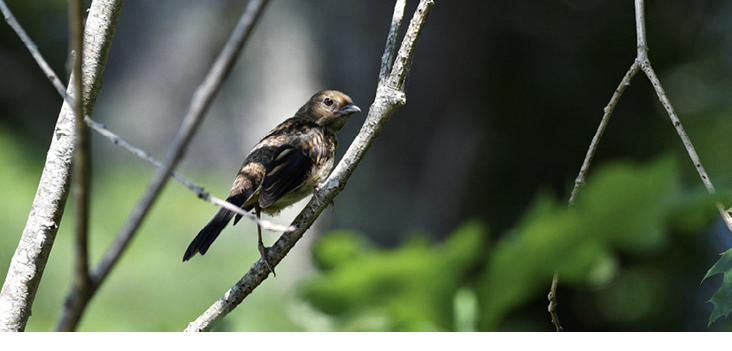Wayne R. Petersen

David Clapp
For the second issue in a row, the mystery species possesses a conical bill suggestive of a member of either the Family Emberizidae or Fringillidae. The online color image fails to show any of the bright reddish, pink, or yellow color characteristics of some of the fringillids, or the small bill, fine streaky plumage, and short tail of other species such as Common Redpoll and Pine Siskin. Although a female or juvenile Brown-headed Cowbird also has a conical bill similar to members in the two families above, the presence of brownish patterning on the back, nape, and rump of the mystery bird, along with some white feathering on the wings and a long tail, are inappropriate features for a cowbird. With these points in mind, the mystery species is likely an emberizid of some sort.
The mottled appearance on the back and light streaks on the sides suggest that the bird is a juvenile. Few sparrows in any plumage exhibit the mottled pattern present on the back of the bird in the photograph, especially in combination with black wings and a long black tail. Indeed, when these features are considered along with the fairly large size of the mystery bird—its overall size, long tail, and stout longish legs can be judged in the context of the leafless twigs the bird is sitting on—there are no sparrows that are a good match for the mystery species.
Remembering that towhees are also emberizids, the shape of the mystery bird is appropriate for a towhee, as are the shape of its bill, the black tail, and black wings with white markings on them. The mottled and streaky appearance of the back and rump are also perfectly consistent with a juvenile towhee. These features point to the identification of the mystery species as a juvenile male Eastern Towhee (Pipilo erythrophthalmus).
Eastern Towhees are common spring and fall migrants and summer residents in brushy pastures, forest edges, and deciduous or mixed forests with a thick understory, especially on the coastal plain and at lower elevations in the interior of Massachusetts. Small numbers regularly winter in thickets on Cape Cod and along the coast, and a few also routinely visit feeders. David Clapp photographed this juvenile Eastern Towhee in Harwich, Barnstable County, Massachusetts on August 1, 2021.
Wayne R. Petersen